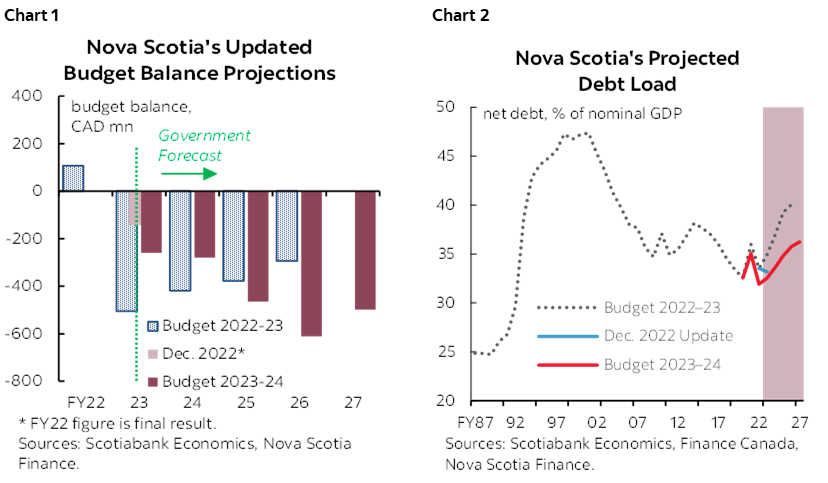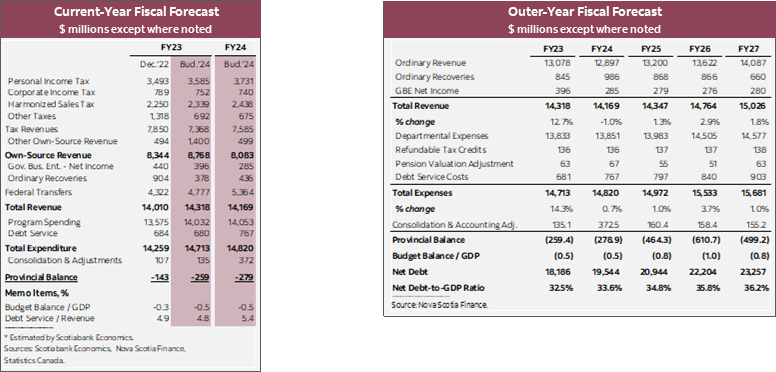RAMPED UP SPENDING TO ADDRESS HEALTHCARE GAPS
- Budget balance forecasts: -$259 mn (-0.5% of nominal GDP) in FY23, -$279 mn (-0.5%) in FY24, -$464 mn (-0.8%) in FY25, -$611 mn (-1.0%) in FY26, and -$499 mn (-0.8%) in FY27 (chart 1).
- Net debt: strong nominal GDP growth in 2021 pushed the net debt-to-GDP ratio down in FY22, but net debt growth is expected to outpace nominal GDP, increasing the ratio up from 32.5% in FY23 to 36.2% in FY27 (chart 2).
- Real GDP growth forecasts: +2.9% in 2022, +0.6% in 2023, and 1.1% in 2023.
- While the budget ramps up spending, mostly in healthcare, increasing the deficit through FY26, it follows through with a main campaign promise to address strains on the healthcare system. The deficit is forecast to decline only by FY27.

OUR TAKE
The budget adds substantial new funding to address major gaps in Nova Scotia’s healthcare system, while otherwise restraining spending in other areas. The outlook presented in Budget 2023–24 expects to run deficits that will increase from -$259 mn (-0.5% of nominal GDP) in FY23 to -$611 mn (-1.0%) in FY26, before falling to -$499 mn (-0.8%) in FY27. This is in contrast to last year’s budget which expected deficits of -$506 mn (-1.0%) in FY23 falling to -$294 mn (-0.5%) in FY26.
Growth in total expenses is expected to be muted in FY24, before increasing through FY26. The largest change in spending is on Health and Wellness, expected to increase more than $310 mn, totalling $4,854 mn in FY24. On the other side of the ledger, lower spending on Environment and Climate Change which was nearly $160 mn above budget in FY23 due to hurricane Fiona. Total revenue is expected to fall by 1% in FY24, primarily due to lower net income from government business enterprises, and then increase by more than 1% per year in the outer years, with the growth coming solely from ordinary revenue.
The net debt-to-GDP ratio fell to 31.9% in FY22 owing in large part from nominal GDP growth above 10% in 2021, meanwhile net debt increased 1.0% that same year. With GDP growth forecasted to slow down to only 0.6% in real terms and 4.0% in nominal terms in 2023 then grow around 1% real and 3.3% nominal per year thereafter, slightly below longer-term averages, net debt-to-GDP is expected to increase to 36.2% by FY27 as net debt is expected to increase more than 6% per year in FY24 through FY26.
Nova Scotia’s borrowing requirements are greater in FY25 and FY26 than what was presented in last year’s budget. Total borrowing requirements are expected to increase to $2.0 bn in FY24, which is below the expected cash requirements due to the pre-borrowing of $680 mn over the past few years. However, total borrowing requirements are expected to be at least $2 bn per year from FY24 through FY26, which is $1.6 bn above the borrowing requirements for those three years presented in last year’s budget. The province expects the Canadian debt market to be their primary source of funding for borrowing in FY24, while maintaining the documentation to borrow in US and global markets.
For a breakdown of the numbers please see tables on page 2.

DISCLAIMER
This report has been prepared by Scotiabank Economics as a resource for the clients of Scotiabank. Opinions, estimates and projections contained herein are our own as of the date hereof and are subject to change without notice. The information and opinions contained herein have been compiled or arrived at from sources believed reliable but no representation or warranty, express or implied, is made as to their accuracy or completeness. Neither Scotiabank nor any of its officers, directors, partners, employees or affiliates accepts any liability whatsoever for any direct or consequential loss arising from any use of this report or its contents.
These reports are provided to you for informational purposes only. This report is not, and is not constructed as, an offer to sell or solicitation of any offer to buy any financial instrument, nor shall this report be construed as an opinion as to whether you should enter into any swap or trading strategy involving a swap or any other transaction. The information contained in this report is not intended to be, and does not constitute, a recommendation of a swap or trading strategy involving a swap within the meaning of U.S. Commodity Futures Trading Commission Regulation 23.434 and Appendix A thereto. This material is not intended to be individually tailored to your needs or characteristics and should not be viewed as a “call to action” or suggestion that you enter into a swap or trading strategy involving a swap or any other transaction. Scotiabank may engage in transactions in a manner inconsistent with the views discussed this report and may have positions, or be in the process of acquiring or disposing of positions, referred to in this report.
Scotiabank, its affiliates and any of their respective officers, directors and employees may from time to time take positions in currencies, act as managers, co-managers or underwriters of a public offering or act as principals or agents, deal in, own or act as market makers or advisors, brokers or commercial and/or investment bankers in relation to securities or related derivatives. As a result of these actions, Scotiabank may receive remuneration. All Scotiabank products and services are subject to the terms of applicable agreements and local regulations. Officers, directors and employees of Scotiabank and its affiliates may serve as directors of corporations.
Any securities discussed in this report may not be suitable for all investors. Scotiabank recommends that investors independently evaluate any issuer and security discussed in this report, and consult with any advisors they deem necessary prior to making any investment.
This report and all information, opinions and conclusions contained in it are protected by copyright. This information may not be reproduced without the prior express written consent of Scotiabank.
™ Trademark of The Bank of Nova Scotia. Used under license, where applicable.
Scotiabank, together with “Global Banking and Markets”, is a marketing name for the global corporate and investment banking and capital markets businesses of The Bank of Nova Scotia and certain of its affiliates in the countries where they operate, including; Scotiabank Europe plc; Scotiabank (Ireland) Designated Activity Company; Scotiabank Inverlat S.A., Institución de Banca Múltiple, Grupo Financiero Scotiabank Inverlat, Scotia Inverlat Casa de Bolsa, S.A. de C.V., Grupo Financiero Scotiabank Inverlat, Scotia Inverlat Derivados S.A. de C.V. – all members of the Scotiabank group and authorized users of the Scotiabank mark. The Bank of Nova Scotia is incorporated in Canada with limited liability and is authorised and regulated by the Office of the Superintendent of Financial Institutions Canada. The Bank of Nova Scotia is authorized by the UK Prudential Regulation Authority and is subject to regulation by the UK Financial Conduct Authority and limited regulation by the UK Prudential Regulation Authority. Details about the extent of The Bank of Nova Scotia's regulation by the UK Prudential Regulation Authority are available from us on request. Scotiabank Europe plc is authorized by the UK Prudential Regulation Authority and regulated by the UK Financial Conduct Authority and the UK Prudential Regulation Authority.
Scotiabank Inverlat, S.A., Scotia Inverlat Casa de Bolsa, S.A. de C.V, Grupo Financiero Scotiabank Inverlat, and Scotia Inverlat Derivados, S.A. de C.V., are each authorized and regulated by the Mexican financial authorities.
Not all products and services are offered in all jurisdictions. Services described are available in jurisdictions where permitted by law.

